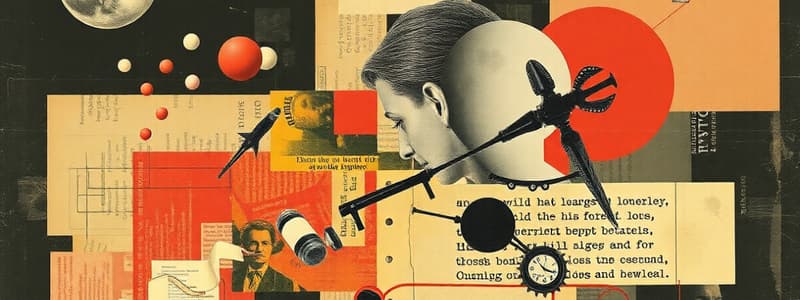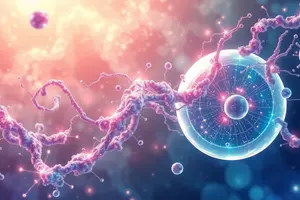Podcast
Questions and Answers
What is the primary action of Beta-Blockers on cellular activities?
What is the primary action of Beta-Blockers on cellular activities?
- Depress cellular activities (correct)
- Interfere with foreign body growth
- Replace missing substances
- Increase cellular activities
Which neurotransmitter contributes to muscle contraction and memory?
Which neurotransmitter contributes to muscle contraction and memory?
- Dopamine
- Acetylcholine (correct)
- Norepinephrine
- Serotonin
What is the purpose of the 'A' in LADME within pharmacokinetics?
What is the purpose of the 'A' in LADME within pharmacokinetics?
- Administration
- Absorption (correct)
- Accumulation
- Activation
During which stage does the drug bind to receptors in pharmacodynamics?
During which stage does the drug bind to receptors in pharmacodynamics?
What is a common effect of excess Norepinephrine and Epinephrine?
What is a common effect of excess Norepinephrine and Epinephrine?
Which type of drug action involves the interaction with enzymes?
Which type of drug action involves the interaction with enzymes?
What type of absorption method provides the most rapid entry of a drug into the bloodstream?
What type of absorption method provides the most rapid entry of a drug into the bloodstream?
What is the primary role of epidural administration in pharmacodynamics?
What is the primary role of epidural administration in pharmacodynamics?
What is the function of an agonist in drug-receptor interactions?
What is the function of an agonist in drug-receptor interactions?
Which medication is specifically indicated for treating tachycardia in hyperthyroidism?
Which medication is specifically indicated for treating tachycardia in hyperthyroidism?
What does the first-pass effect refer to?
What does the first-pass effect refer to?
Which condition is associated with a lack of dopamine?
Which condition is associated with a lack of dopamine?
What is the primary effect of glucocorticoids?
What is the primary effect of glucocorticoids?
What is the primary action of a competitive antagonist?
What is the primary action of a competitive antagonist?
Which medication is used as a prophylaxis for migraine?
Which medication is used as a prophylaxis for migraine?
In which condition is Phentolamine primarily used?
In which condition is Phentolamine primarily used?
Which neurotransmitter is specifically mentioned in the context of anti-psychotic treatment?
Which neurotransmitter is specifically mentioned in the context of anti-psychotic treatment?
What distinguishes atypical antipsychotics from typical antipsychotics?
What distinguishes atypical antipsychotics from typical antipsychotics?
Which drug is known to cause bradycardia as a side effect?
Which drug is known to cause bradycardia as a side effect?
What condition is Doxazosin primarily indicated for?
What condition is Doxazosin primarily indicated for?
What role does excretion play in metabolism?
What role does excretion play in metabolism?
What effect does hepatic detoxification have on drugs?
What effect does hepatic detoxification have on drugs?
What is the primary mechanism of action for Chromolyn Sodium?
What is the primary mechanism of action for Chromolyn Sodium?
Which medication is NOT classified as a beta-adrenergic blocker?
Which medication is NOT classified as a beta-adrenergic blocker?
What is the primary route for the excretion of unmetabolized Naloxone from the body?
What is the primary route for the excretion of unmetabolized Naloxone from the body?
Which neurotransmitter is primarily associated with the 'Nerves: Serotonergic' mentioned in the content?
Which neurotransmitter is primarily associated with the 'Nerves: Serotonergic' mentioned in the content?
Which medication is specifically indicated for Acetaminophen overdose?
Which medication is specifically indicated for Acetaminophen overdose?
Which of the following is categorized as a non-competitive antagonist?
Which of the following is categorized as a non-competitive antagonist?
What type of neurotransmitter is Gamma-aminobutyric acid (GABA)?
What type of neurotransmitter is Gamma-aminobutyric acid (GABA)?
Which drug is primarily used for hypertension?
Which drug is primarily used for hypertension?
What side effect is associated with short acting beta agonists (SABA)?
What side effect is associated with short acting beta agonists (SABA)?
Which of the following drugs is a long-acting beta agonist (LABA)?
Which of the following drugs is a long-acting beta agonist (LABA)?
In which condition is Terbutaline NOT typically used?
In which condition is Terbutaline NOT typically used?
What is the effect of Midodrine when used in patients?
What is the effect of Midodrine when used in patients?
Flashcards are hidden until you start studying
Study Notes
Pharmacology Overview
- Pharmacodynamics relates to the actions of drugs on the body.
- Pharmacokinetics involves the body's response to drugs, summarized by "LADME": Liberation, Absorption, Distribution, Metabolism, and Excretion.
- Neurotransmitters serve as chemical messengers, produced by nerves to regulate body functions.
Drug Actions and Mechanisms
- Drugs may replace missing substances (e.g., insulin, cortisol) or affect cellular activity (e.g., epinephrine stimulates; beta-blockers depress).
- Antibiotics inhibit the growth of foreign organisms.
- Drug actions occur through various mechanisms: binding to receptors, interacting with enzymes, engaging pumps, and combining chemically.
Drug-Receptor Interactions
- An agonist, such as morphine, stimulates a receptor to produce effects.
- A competitive antagonist blocks receptor sites, preventing drug action (e.g., alpha blockers), impacting conditions like hypertension.
- Non-competitive antagonists reduce agonist effects without competing for the same site (e.g., certain antibiotics).
Pharmacokinetic Processes
- Liberation: Release of active drug ingredients.
- Absorption:
- Routes and rates vary; IV is fastest, followed by IM, SUBQ, and oral.
- Distribution:
- Drugs travel to target tissues, influenced by blood flow and formulation.
- Metabolism:
- Primarily occurs in the liver; transforms drugs into inactive forms (First-pass effect reduces efficacy).
- Excretion:
- Mainly through kidneys, also via gastrointestinal tract and skin.
Key Neurotransmitters
- Acetylcholine (Ach):
- Critical for muscle contraction and memory.
- Lacks in Alzheimer’s; excess can lead to mania.
- Norepinephrine/Epinephrine (NE/Epi):
- Involved in fight-or-flight response.
- Lacking may cause depression; excess can cause mania.
- Dopamine:
- Influences motor control and behavior.
- Low levels are linked to Parkinson’s; high levels may lead to schizophrenia.
- Serotonin (5-HT):
- Regulates mood and anxiety.
Drug Classes and Uses
- Alpha Adrenergic Antagonists:
- Used to treat hypertension (e.g., Prazosin, Doxazosin) and manage urinary issues in BPH.
- Beta-Adrenergic Blockers:
- Treat tachycardia and migraine prophylaxis (e.g., Propranolol, Timolol).
Corticosteroids and Inhalation Medications
- Glucocorticoids: Provide anti-inflammatory effects; immune suppression.
- Leukotriene Modifiers: Induce smooth muscle constriction.
- Cromolyn Sodium: Stabilizes mast cells, preventing histamine release.
Side Effects and Contraindications
- Common Side Effects: Bradycardia and hypotension; monitor heart rate and blood pressure before administration.
- Specific Medications:
- Caffeine and related compounds can exacerbate symptoms in certain conditions.
Drug Interactions and Clinical Applications
- Short Acting Decongestants: Cause vasoconstriction (e.g., Methyldopa) with potential hypotension.
- Beta Agonists: SABA for emergency use; LABA for long-term control of asthma and COPD.
- Tocolytic Agents: Facilitate muscle contraction prevention in preterm labor (e.g., Terbutaline).
Studying That Suits You
Use AI to generate personalized quizzes and flashcards to suit your learning preferences.




